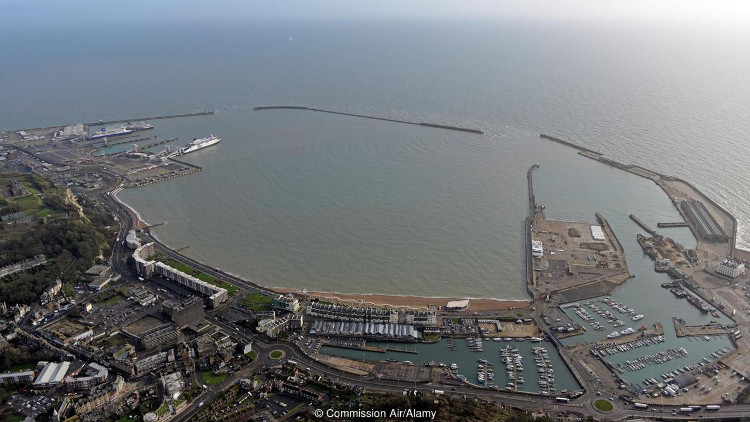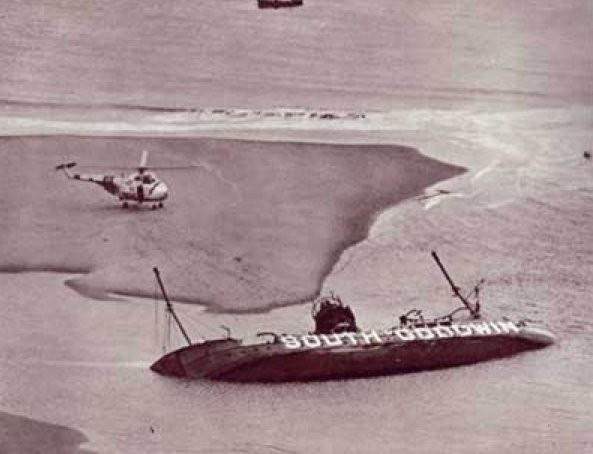Visiting the 'graveyard' of thousands of giant ships is in danger of disappearing forever
A peaceful sandy beach off Kentish is home to over 1000 wrecks, and is also a historical remnant of war.
Goodwin Sands is a long sandy beach (about 16km) at the southern end of the North Sea, located about 10km off the coast of Deal in Kent, England. It possesses a diverse ecosystem with many typical marine species, and is proposed by Wildlife Trust to become a marine protected area in the future.

The panorama of Goodwin sand.
In 2016, Goodwin faced the risk of disappearing because Dover's board of management planned to dredge 2.5 million tons of sand to expand the port. Thankfully, the management board has been encumbered by people because of environmental factors. However, there is another reason, because .
"Goodwin is also Britain's largest underwater cemetery"
Hidden beneath the surface of the water, Goodwin is one of the most dangerous locations of the British Canal. When storms sweep, they can cause fatal disasters.

Hidden beneath the surface of the water, Goodwin is one of the most dangerous locations of the British Canal.
At the end of November 1703, South England witnessed the worst natural disaster in history. The storm called the Great Storm killed more than 1,000 sailors on the sand.
Among the many ships sunk that night, including HMS Stirling Castle - a giant warship. In 1979, it was discovered by a local diver, and since 1980 was recognized as a wreck protected under the Submersible Ship Protection Act of 1973.
On January 24, 1809, an East India Company ship loaded goods, including many iron ore, bullets, anchors and 48 tons of Indian coins, departing from London to Madras. When the ship crossed the Kent coast, an intense wind came suddenly making it stranded on Goodwin sand along with two other ships that night. Fortunately, only one person died in the event that night.
Three East Indian ships as well as HMS Stirling Castle are just a few of the more than 1,000 ships buried under Goodwin sand. Some believe that the number of shipwrecks exceeds 2,000.

The ships were aground or submerged in this sea area.
"The whole area is a collective war grave" - Stephen Eades
In 2013, Dornier - the last bomber used in World War II was discovered at Goodwin. It was shot down during the British War in 1940.

When the storm swept, Goodwin could cause fatal disasters.
However, there are still some aircraft and their crew still deep in Goodwin's sand. David Brocklehurst of the Kent Battle of Britain Museum compiled a list of 60 aircraft believed to have "landed" or "fallen" on Goodwin sand in 1940. Of these, the crew of at least 50 aircraft are believed to have been killed or missing.
Dredging Goodwin to expand the port faced many objections
The Dover Port Authority said that protected areas would not be affected. Antony Greenwood, the board's spokesman, said the dredging process would be limited to about 0.22% of Goodwin's total sand volume, meaning that it would not affect the overall structure of the site.

Sand at Goodwin is losing.
However, those who oppose this view suggest that Goodwin is a closed system, meaning that sand is an entity, constantly moving around. If dredging in this area, sand in other places in the system will fill again, so it can affect protected ships. In other words, this could erase the entire Goodwin yard.
US Air Force historians then have to check the accuracy of the list Brocklehurst offers and this may upset the dredging process. Under the provisions of the Military Protection Law (1986), that action could infringe on areas with military aircraft debris, or a grave of military sacrifices.
Greenwood argued that potential damage to historical sites could be reduced when archaeological consultants were consulted, to ensure the procedures were followed. However, in a letter to the Maritime Management Organization, the Archeology Association thinks that having observers on dredging boats will not help because "they will only see the damage. when it happened ".
- 10 spectacular destinations are about to disappear on Earth
- Huge graveyard in Australia
- Crystal caves in Mexico are in danger of disappearing
- For thousands of years of green forever: Change living behavior
- Mysterious ghost ships (part 2)
- Tens of thousands of medicinal plants are about to disappear forever
- 10 stunning landscapes are in danger of disappearing
- Accidentally discovered the graveyard of hundred-year-old boats and ships on the seabed
- The 7,000-year-old graveyard was buried at the bottom of the sea
- Decode the mysterious cemetery about 3400 years
- Egypt discovered an ancient graveyard of more than 2,000 years old
- Two 'ghosts' in Australian cemetery
 'Fine laughs' - Scary and painful torture in ancient times
'Fine laughs' - Scary and painful torture in ancient times The sequence of numbers 142857 of the Egyptian pyramids is known as the strangest number in the world - Why?
The sequence of numbers 142857 of the Egyptian pyramids is known as the strangest number in the world - Why? History of the iron
History of the iron What is alum?
What is alum?